WATER: A PRECIOUS RESOURCE for Class 7 SCIENCE
INTRODUCTION
Hamare chapter ka name hai “Water: A precious resource”, toh iss chapter mein hum water ke baare mein padhenge. Hum janege ki hamare planet earth par kitna water present hai aur woh kis-kis form mein available hai. Yaha par hum earth par water ke distribution ke baare mein bhi janege ki total water mein se kitna aisa water hai jo hamare use ke liye available hai. Groundwater kya hota hai, kaise replenish hota hai, water table kya hoti hai, etc. ke baare mein bhi hum janenge. Hum yaha water management ki kuchh techniques ke baare mein bhi janege kyonki aaj-kal water ki scarcity hai aur water level down hota ja raha hai aur dekhenge ki water management mein hum kya role play kar sakte hai. Aaj ki situation ko dekhte huve aisa estimate kiya jata hai ki aane wale kuchh years mein one third se jyada log water scarcity face karenge. Year 2003 ko International year of freshwater ki tarah observe kiya jata hai.Water scarcity ka humans par hi nahi plants par bhi effect padta hai, yaha hum plants par water scarcity ke effects ke baare mein bhi janege. Water se related kuchh slogans bhi humne sune hai-
How Much Water Is Available?
Earth par bahut saara water present hai, agar hum space se dekhte hai toh hamein almost poori earth blue dikhai deti hai kyonki iska 71% part water se covered hai. Lekin yeh sara water human consumption ke liye available nahi hai kyonki yeh water mostly seas, oceans, rivers, lakes, ice caps, etc. mein present hai. Hum sirf freshwater use kar sakte hai, toh iss total water ka sirf kuchh hi part hum use kar sakte hai.
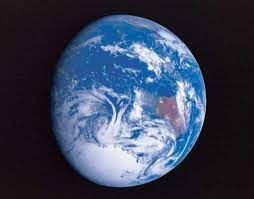
Forms Of Water
Ab hum water ki forms ke baare mein padhenge. Jaisa ki hamne class 6 mein bhi padha hai ki earth par water ki availability ko water cycle maintain karta hai. Water three different forms mein exist karta hai- solid, liquid aur gas. Jab water, water cycle mein circulate karta hai toh yeh inn teeno forms mein dekha ja sakta hai.
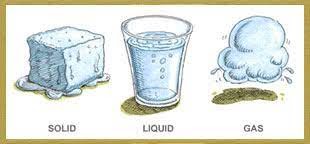
Water ki solid form, snow aur ice, earth ke poles ki ice caps par, snow covered mountains aur glaciers, etc. par paayi jati hai.
Water ki liquid form, oceans, lakes, rivers aur underground water ki tarah paayi jati hai.
Water ki gaseous form jo ki water vapour hoti hai woh hamare aas-paas present air mein hi available hoti hai.
Water cycle ki help se water apni teeno states mein convert hota rehta hai aur earth par water ka amount constant rehta hai. Mostly urban areas mein aaj-kal well developed water supply system hai lekin abhi bhi kuchh aise areas hai jo undeveloped hai aur woh water ke liye rivers, lakes, ponds, handpumps, etc. jaise resources par depend karte hai.
Lekin kya aapne kabhi socha hai ki inn sources mein paani kaha se aata hai?

Groundwater As An Important Source Of Water
Groundwater hamare liye fresh water ka main resource hai kyonki hum wells, tubewells, handpumps, etc. mein se water use karte hai aur unme bhi water groundwater se hi aata hai. Ground ke neeche soil aur rocks ke beech ke gaps mein water present hota hai. Iss water layer ke upper level ko hum water table kehte hai. Water table place to place vary karta hai kyonki har place par water level different hota hai. Ek particular place ka water level change hota rehta hai isliye uss place ka water table bhi change ho sakta hai.
Water table ki koi particular depth nahi hoti, kahin toh yeh ek ya do metres ki depth par mil jata hai aur kahi bahut deep dig karne par hi milta hai.
Water table ke neeche jo water present hota hai usko hum groundwater kehte hai. Ponds, rivers, rainwater, etc. ka water slowly-slowly soil mein se seep hota hai aur groundwater level ko recharge karta hai. Water ke soil mein se ground mein seep karne ke iss process ko infiltration kehte hai.
Kuchh places par groundwater, water table ke neeche hard rocks ki layers mein store hota hai. Isko hum aquifer kehte hai. Aquifers mein se water handpumps aur tubewells ki help se nikala jata hai. Lekin inn resources mein ek limited amount mein hi water present hota hai aur agar inko excessively use kiya jaye toh yeh finish ho jayenge.
Depletion Of Water Table
Underground water jo hum ground se nikalte hai woh rainwater ke ground mein seep hone se replenish hota hai. Jab tak hum limit mein iss water ko use karenge tab tak yeh sath-sath natural processes ki help se replenish hota jayega lekin agar hum iss water ko excessively use karenge toh yeh groundwater replenish nahi ho payega aur water table bahut down chala jayega. Aaj-kal bahut saare factors jaise industrialisation, population increase, deforestation, less rainfall aur agricultural activities, etc. ki wajah se water table deplete hota ja raha hai.

Increasing population
Aaj-kal population bahut increase hoti ja rahi hai jiski wajah se logo ko houses, offices, roads aur pavements etc. ke liye space ki jyada jarurat hai. Iske liye log har jagah constructions kar rahe hai aur rainwater ka ground mein seepage ka area decrease hota ja raha hai jiski wajah se groundwater recharge nahi ho pata hai aur sirf usage ki wajah se iska level decrease hota ja raha hai.Agricultural Activities
Agriculture ke liye farmers ko bhi bahut water ki need hoti hai. Kuchh places par toh proper rainfall hota hai jisse farmers ki water need poori ho jati hai, kuchh places par irrigation system jaise canals wgarah present hai lekin kuchh places aise bhi hai jaha na to rainfall proper hota hai na hi irrigation system available hai toh waha par farmers irrigation ke liye ground water use karte hai. Population increase ki wajah se agriculture ki demand bhi increase hoti hai aur isse irrigation ke liye water ki demand bhi increase hoti hai toh groundwater ka usage bhi jyada hota hai jiski wajah se day by day water table level decrease hota ja raha hai.Distribution Of Water
Earth par water ka distribution uneven hai, iske liye bahut saare factors responsible hai. India ek vast country hai aur yaha har jagah par different amount mein rainfall hota hai. Eg- Kuchh places par toh bahut jyada rain hoti hai aur kuchh places par bilkul bhi nahi hoti jiski wajah se kuchh places par toh water bahut jyada rehta hai jiski wajah se floods, etc. cause hoti hai aur kuchh places par bilkul sookha rehta hai.
Hum neeche map mein India ke different parts ka average rainfall dekh sakte hai.
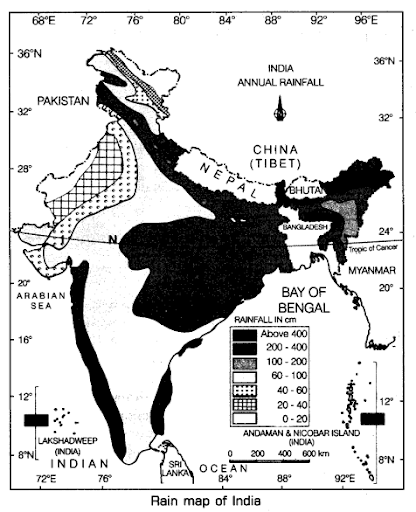
Water Management
Hum jante hai ki hamare areas mein pipelines ke through water supply kiya jata hai lekin leaking pipes, etc. ki wajah se bahut saara water waste hota rehta hai aur apni destination tak bhi nahi pahunch pata. Yeh civic authorities ki responsibility hai ki precious water ka aisa wastage na ho.
Hum log bhi daily knowingly aur unknowingly water ka bahut wastage karte hai, eg- brush karte huve hum tap open leave kar dete hai, bathing mein, washing mein, leaking taps ke through, etc. Hamein bhi water ko har ek activity ke liye carefully use karna chahiye kyonki hamare paas fresh water ek limited amount mein hi present hai. Hamein fresh water ko save karna chahiye kyonki, “Jal Hai, To Kal Hai”.
Water ke management ke liye hum kuchh steps le sakte hai-
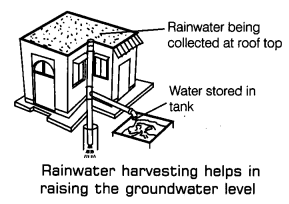
A Case Study
Bhujpur, jo ki Gujarat ke Kutch area mein present hai waha par rainfall ka koi pattern nahi hai aur waha par rainfall bahut hi unpredictable hai. Waha par sirf groundwater hi fresh water ka source hai kyonki yaha poore year hi rivers mein water nahi rehta. Only source hone ki wajah se yaha groundwater ka withdrawal groundwater recharge se bahut jyada hai jiski wajah se yaha water table level bahut down chala gaya hai. 1989 mein villagers ne non-government organisations ke sath mil kar rainwater harvesting karne ko decide kiya. Iske liye Rukmavati river aur uski tributaries par 18 check-dams banaye gaye. Jo water waha collect huva usne soil mein se percolate ho kar aquifers ko recharge kiya. Farmers ke according ab wells mein water bhi hai aur jo water sea mein flow down hone ki wajah se waste ho jata tha woh ab irrigation ke liye available rehta hai. Bawris: Bawris water collection ka ek bahut old aur traditional system hai. Yeh structures hamein abhi bhi old palaces, forts, etc. mein dekhne ko milte hai. Lekin dheere-dheere log iske usage ko bhool gaye and bawris fell into disguise, log isme garbage throw karne lag gaye. Ab dobara se aisi situation aa gayi hai ki acute water shortage ki wajah se inn areas ke logo ko bawris system ke baare mein dobara sochne ki jarurat pad gayi hai. Bawris ko fir se revive kiya ja raha hai jiski wajah se scanty rainfall ke baad bhi inn places par water needs bahut achhe se fulfill ho rahi hai.

Drip irrigation: Yeh ek irrigation technique hai jisme hum narrow tubings ka use karke directly plants ke base par water deliver karte hai.
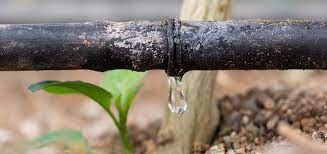
What Role You Can Play
Hum water ko save karne ke liye ek bahut important role play kar sakte hai. Hum water ki wastage ko minimise karne ke liye water-wise habits ko apna sakte hai, eg-leaking tap ko thik karke water ka wastage stop kar sakte hai, bathing, brushing, washing, etc. mein kum se kum water use karke water ka wastage rok sakte hai, floor ko regularly wash karne ke bajaye mop kar sakte hai, hum aise aur bhi bahut saare examples apni daily life mein dekh sakte hai.
Effect Of Water Scarcity On Plants
Hum apne ghar mein plants grow karte hai jinko hum potted plants kehte hai. Potted plants ko regularly water ki need hoti hai, inko agar kuchh din bhi paani na diya jaaye toh yeh dry hona shuru ho jate hai, inki leaves wilt honi start ho jati hai aur plant ultimately die ho jata hai. Plants ko soil se apne nutrients lene ke liye aur photosynthesis perform karne ke liye water ki need hoti hai, iske bina woh apna khana nahi bana sakte. Agar plants ko proper water na mile toh iska green character lost hone lagta hai. Agar plants nahi honge toh na hi food available hoga, na oxygen available hogi, na enough rain hogi, iske alawa aur bhi bahut saari problems create ho jayengi. Water scarcity se plants khatam hote jayenge aur plants ke bina hum apni life imagine bhi nahi kar sakte.POINT 1
Water cycle: The water cycle is often taught as a simple circular cycle of evaporation, condensation, and precipitation.
Water table: water table, also called groundwater table, upper level of an underground surface in which the soil or rocks are permanently saturated with water.
Infiltration: Infiltration is the process by which water on the ground surface enters the soil.
Aquifer: An aquifer is a body of saturated rock through which water can easily move.
Rainwater harvesting: Rainwater harvesting (RWH) is the collection and storage of rain, rather than allowing it to run off.
Depletion of water: water depletion means a continuous reduction of water resources and deterioration of surface and groundwater quality.
SUMMARY
1. Water is essential for all living beings. There can be no life without it.
2. Water exists in three forms: solid, liquid and vapour.
3. Though water is maintained by the water cycle, yet there is an acute scarcity of water in many parts of the globe.
4. There is an uneven distribution of water. Much of it has resulted from human activities.
5. Rapid growth of industries, increasing population, growing irrigation requirements and mismanagement are some of the causes for water shortage.
6. We need to be worried about the wastage during the supply of water through pipes, the leaking taps in buildings and other places. Unnecessary use of water and overdrawing from groundwater should be avoided. Recharge of water to the ground should be increased.
7. The need of the hour is that every individual uses water economically.
Plants wilt and ultimately dry-up if they are not watered for a few days.